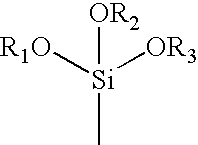Method for making an absorbent binder composition and application thereof to a substrate
- Summary
- Abstract
- Description
- Claims
- Application Information
AI Technical Summary
Benefits of technology
Problems solved by technology
Method used
Image
Examples
example
A first aqueous monomer solution was prepared as follows. First, 21.0 grams (0.53 moles) of sodium hydroxide was dissolved in 138.4 grams of deionized water. The resulting sodium hydroxide solution was cooled with an ice bath to room temperature. Then, a neutralized acrylic acid solution was formed by adding 48 milliliters (0.70 moles) of acrylic acid to the cooled sodium hydroxide solution. Thereafter, a total of 68 grams of 10% (w / w) sodium hydroxide solution was added to the neutralized acrylic acid solution to adjust the pH to 6.8. Next, 0.6215 grams (3.53×10−3 moles) of ascorbic acid was dissolved in the neutralized acrylic acid solution. Following dissolution of the ascorbic acid, 0.55 milliliters (0.6 grams) of AEROSOL OT surfactant was added to the solution and the solution was placed on a hot plate and heated to about 40 degrees Celsius to fully dissolve the surfactant. Finally, 2.6 milliliters (1.41×10−2 moles) of 3-(trimethoxysilyl)propyl methacrylate was added to the sol...
PUM
| Property | Measurement | Unit |
|---|---|---|
| Fraction | aaaaa | aaaaa |
| Fraction | aaaaa | aaaaa |
| Glass transition temperature | aaaaa | aaaaa |
Abstract
Description
Claims
Application Information
 Login to View More
Login to View More - R&D
- Intellectual Property
- Life Sciences
- Materials
- Tech Scout
- Unparalleled Data Quality
- Higher Quality Content
- 60% Fewer Hallucinations
Browse by: Latest US Patents, China's latest patents, Technical Efficacy Thesaurus, Application Domain, Technology Topic, Popular Technical Reports.
© 2025 PatSnap. All rights reserved.Legal|Privacy policy|Modern Slavery Act Transparency Statement|Sitemap|About US| Contact US: help@patsnap.com

